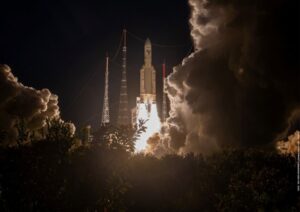Min-Uh Ko and his team at Fraunhofer ILT have set their sights on nothing less than the successful future of the European space industry. Within the ENLIGHTEN (European iNitiative for Low cost, Innovative & Green High Thrust ENgine) project, the scientists are working on new technologies to lower the costs of space travel and bolster Europe’s ability to compete in this field. There are 18 partners involved in the project, which is receiving active support from the European Commission with the aim of maintaining technological sovereignty and being able to operate autonomously amid increasing global competition.
Pushing the limits of possibility
Too expensive, too slow: The experts at Fraunhofer ILT are literally bringing fresh propulsion to European space travel as part of the project. Their plan is to produce the nozzle of a rocket engine using an additive manufacturing method known as laser material deposition (LMD) and build a demonstrator to scale. This reconceptualized production method in itself is a crucial step toward greater cost efficiency and accelerated workflows.
“The special aspect is how the wide range of possibilities offered by LMD technology drastically improve the speed and cost-effectiveness of manufacturing new generations of rocket nozzles. Apart from its large build envelope, the design being investigated has exceptionally fine, thin-walled cooling channels that require great effort to be implemented in conventional production routines,” explains Ko, the coordinator for this subproject.
Flexible, productive, accurate — and thus groundbreaking
Other methods, such as wire and arc additive manufacturing (WAAM) and laser powder bed fusion (LPBF), are either unable to produce comparably intricate structures or have significantly lower productivity than LMD. On top of that, there are significant size limitations with LPBF in particular. “What’s exciting about LMD technology is that the process principle can be transferred to almost any kind of kinematic system. And that means the size is also easy to scale,” Ko notes.
The thruster’s thin-walled structures require laser sources with a specific beam quality that produce a beam with an exceptionally small diameter. “We’re extra strong in this area because we have various laser sources and optical configurations in-house that we can adjust to the individual application,” says Jochen Kittel, ENLIGHTEN project manager at Fraunhofer ILT.
Putting rocket manufacturing into overdrive
The nozzle being developed at Fraunhofer ILT is designed for use as a component in the next generation of rockets to emerge from the Ariane program. ArianeGroup is the overall coordinator in charge of the ENLIGHTEN project. In fact, the rocket nozzle can already be produced using conventional methods. But the process currently involves many individual sequential steps, which brings time and cost challenges. Since no provider can carry out all the steps at a single production site, the components have to be moved around to multiple locations. This creates a process chain that significantly extends the production and delivery times.
“A process technology that eliminates many individual steps will significantly reduce costs, but that’s not all. At the same time, we will be considerably shortening the time needed to produce a rocket nozzle. Right now, the process takes well over several months, spanning more than one quarter,” Kittel points out.
An enabler for industry
Beyond the production technology and realizing the demonstrator, the experts at Fraunhofer ILT are also focusing on process monitoring and quality assurance. The team’s goal is to optimize the reliability and robustness of the technologies developed at Fraunhofer ILT to the point that the researchers can transfer them to industry for future mass production. For that reason, a process monitoring system is being used at the same time with the goal of harnessing sensor data to localize and eliminate potential process anomalies, thereby ensuring component quality across the board.
“Once we’ve developed the process and the demonstrator successfully, it will be a breakthrough. With our results, we can make it possible for industry to produce structures that are just as large, complex, and intricate using LMD at their own facilities to supply the aerospace industry,” Ko says with conviction.
Joining forces to reach the stars
The initiative of the partners working on the ENLIGHTEN project shows that if Europe joins forces, it can continue to play an important role in global space travel and exploration. The ILT experts will be presenting the latest findings from the ongoing project for a reliable and competitive European space transportation system at the joint Fraunhofer booth at the Hannover Messe in Hall 2, Booth B24, from April 22 to 26, 2024. Thanks to projects like these, the future of European space transportation systems looks bright.
Source: Fraunhofer Institute for Laser Technology ILT (ilt.fraunhofer.de)
